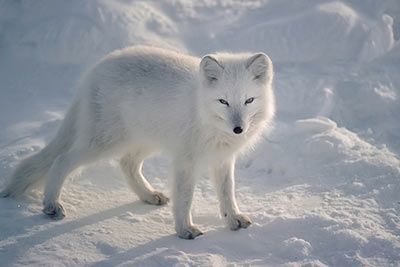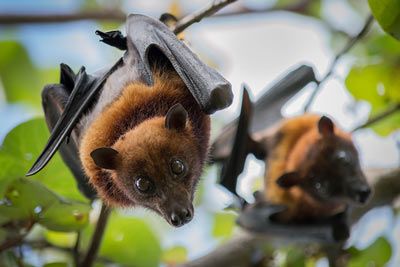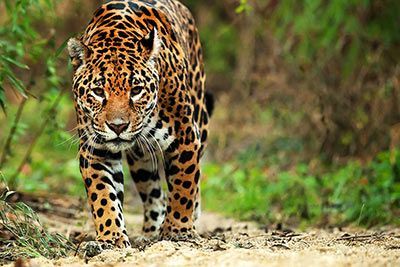Red Fox
Red Fox Facts
| Size | 14-20 inch (35-50 cm) (shoulder height) |
| Speed | Up to 30 mph (50 km/h) (short distance) |
| Weight | 4-22 lb (2-10 kg) |
| Lifespan | 4-5 years |
| Food | Wild animals, fruits |
| Predators | Bears, eagles |
| Habitat | Europa, Asia, America |
| Order | Carnivore |
| Family | Dogs |
| Scientific name | Vulpes vulpes |
| Characteristics | Long, bushy tail |
Main Characteristics
Foxes are predators. They live in forests, grasslands, mountains, deserts or on the coast. There are more than 40 species, for example the Arctic fox, the grey fox, the short-eared fox and the bat-eared fox. The fennec is in fact the smallest fox in the world yet has incredibly long ears! In Germany, the red fox is best known. It is also the most common wild dog in Europe.

Species
Are foxes more like cats or dogs? Foxes are canines (belong to the dog species) but also resemble cats, which is characterized for example by being loners, by their slit shaped eyes or the typical “playing with the prey” behaviour.
Anatomy and Appearance
Size and Weight
Red foxes have a shoulder height of 14-20 inches (35-50 cm). So they are slightly larger than a Shiba Inu or a Beagle. Their tail grows 12-18 inches (30-45 cm) long. The weight varies between 4 and 22 pounds (2-10 kg) - depending on the season and how much food the animals find. The males are slightly larger and heavier than the females.
Fur
Red foxes have soft, silky, thick, long fur. It is yellow-red to reddish-brown on the upper side. On the underside it is light gray to white. The legs and the back of the ears are dark in color.
Tail
Foxes use their bushy tails not only to keep their balance while jumping or chasing, but also to warm themselves or even as a signal flag to communicate with conspecifics.
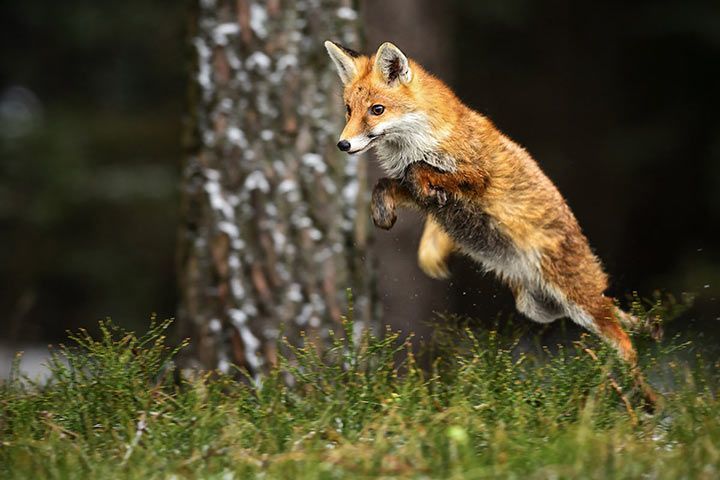
Habitat
Red foxes live primarily in forests and open grasslands. Sometimes even in cities. Depending on the available space and food supply, they roam areas of different sizes. They inhabit an area of 40-50 hectares in the city, 200-700 hectares in forests and up to 3,000 hectares in wide open landscapes. They mark their territory with urine.
Diet
Foxes like to eat small vertebrates, particularly mice, as well as rats, rabbits, squirrels, hedgehogs and geese. Sometimes they even polish off fish, frogs or worms. However, they're not purely meat eaters. They are omnivores. They also savour the marvels of fruit such as plums and raspberries. Sometimes carrion is also part of their diet. There are foxes that live in the city or on the outskirts. Although the city is dangerous to them (just think about cars), there is a big advantage: they don't have to walk far to get food. They plunder people's trash.
Life Style
Up until the 1970s, foxes were believed to be solitary animals. It is true that they are mostly alone when searching for food. But they live in small families. These consist of at least one male and one female. Often, the offspring are part of the family.
Behavior
Winter
Red foxes do not hibernate. They are active during the cold months and roam their habitat in search of food. A thick winter coat keeps them warm. It grows from October and is replaced by the summer coat in April.
Sounds and Calls
Red foxes have 12 different sounds. They bark, babble, trill, scream, whine, whine, and screech. With these vocalizations, they keep in touch with conspecifics, warn or greet each other.
Fox vs. Hedgehog
When a hedgehog curls himself up, he appears to be safe from any danger. From their own painful experience, dogs and cats can tell you a thing or two about scratched noses and paws. Our fox, however, has come up with a very cunning trick: He nudges the hedgehog very carefully with his paw, and rolls him into the nearest pond. The hedgehog is naturally not very fond of so much water. So, he uncurls himself and soaking wet, plods ashore - directly into the claws of the fox.
Foxes Fool Crows
Even crows and other scavengers fall into the trap of the proverbial sly fox: by pretending to be dead. The birds see a "dead" animal and briefly peck at it to see if it is still alive. But suddenly the fox "awakens" form his "rigor mortis" and then snaps at his prey within a split second. For a long time, it was not actually possible to observe this trick. It was then consequently dismissed as a popular folk belief. In the sixties, a wildlife photographer captured this moment on a photo subsequently turning this folk belief into a proven theory (Source: www.fuechse.info).
Senses and Abilities
Jumping
Red foxes can jump over 6.5 feet (2 meters) high fences.
Swimming
Red foxes are good swimmers.
Speed
A fox can run as fast as 30 mph (50 km/h) when chasing his prey. This is faster than permitted when travelling by car in town!
Sense of Hearing
Red foxes have excellent hearing. They can perceive a mouse's squeak 330 feet (100 meters) away.
Sense of Smell
Red foxes can smell very well - but not as well as trained sniffing dogs.
Magnetic Sense
Foxes use the Earth's magnetic field to accurately determine the distance and direction of their prey. They are not the only animals that have a "magnetic sense". Sharks and turtles have it, too. With migratory birds one speaks of a "magnetic compass".
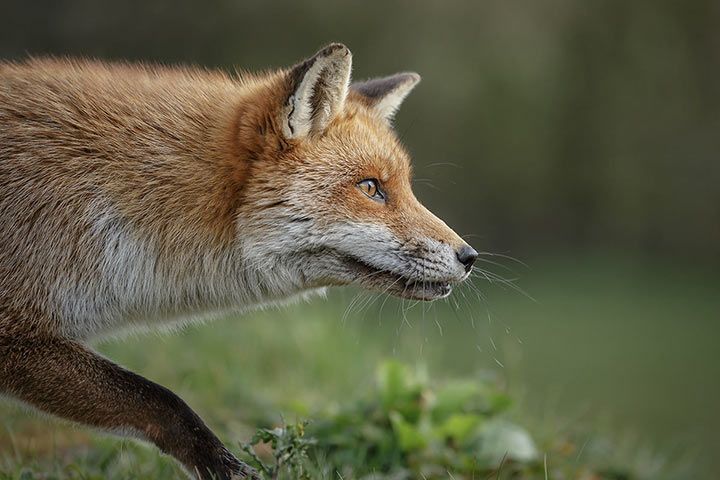
Enemies and Threats
The natural enemies of the red fox are primarily wolves, coyotes, jackals, eagles and eagle owls. They also suffer from diseases, especially tapeworms, fleas and mites.
Hunting
In Germany, more than 400,000 to 500,000 foxes are killed by hunters every year. Often, the animals are shot, but not killed. They suffer a slow, painful death. Scientific studies show that fox hunting is actually not necessary. By hunting, the animals even multiply unnaturally fast (to make up for the losses). Actually, the available food would regulate the number of animals easily. Example: In the Bavarian Forest National Park, these animals have not been hunted for decades. The number of foxes is balanced there.
Importance for the Ecosystem
Red foxes help balance the number of rodents. Since they also eat fruit and travel long distances, they also disperse their seeds and help new plants and trees grow.
Reproduction
Red foxes mate once a year, usually in January or February. After 50 days, the female gives birth to four to six young. She raises them in an underground cave. After two weeks they open their eyes, after four weeks they can eat solid food. Sometimes foxes share their burrow with badgers or other animals. In the city, red foxes also raise their young in garden sheds or garages. Most young die within the first year of life. 95% don't get older than four years.
The Red Fox Is Related To:
- Arctic Fox
- Bat-Eared Fox
- Common Raccoon Dog
- Fennec
Animals in the Same Biome:
- Badger
- Brimstone Butterfly
- Edible Dormouse
- Eurasian Eagle Owl
- Eurasian Jay
- Great Spotted Woodpecker
- Hedgehog
- Mole
- Microbat
- Mouse
- Rabbit
- Raccoon
- Red Squirrel
- Wolf
Video: 13 Facts About Foxes
(Video opens on YouTube)














